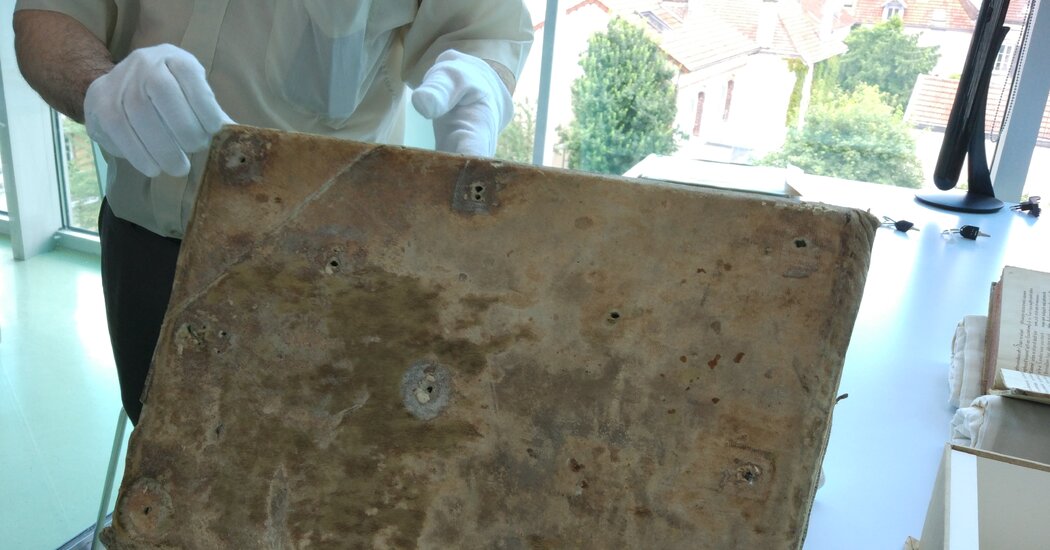Medieval scribes filled volumes called bestiaries with illustrations and descriptions of fantastic creatures. The manuscripts containing representations of these animals also depended on a menagerie of beasts: The covers of these and other volumes were fashioned from the skins of calves, goats, sheep, deer, pigs and, in some macabre instances, humans.
Most of these hides were shorn before they were turned into book bindings. But one set of medieval manuscripts from northeastern France has a peculiar finish: Its weathered covers are covered in clumps of hair.
“These books are too rough and far too hairy to be calfskin,” said Matthew Collins, a bioarchaeologist at the University of Copenhagen and Cambridge University and an author of the new study. But identifying the source of the shaggy leather has proved difficult.
While these furry tomes would seem at home in Hogwarts library, they were originally made in the scriptorium of Clairvaux Abbey, a hub for an order of Catholic monks, the Cistercians. The abbey, founded in 1115 in the Champagne-Ardenne region of France, was home to one of the largest monastic libraries in medieval Europe.
Some 1,450 volumes of the abbey’s extensive corpus survive. Roughly half of these manuscripts remain in their fragile, original bindings. Many were bound during the 12th and 13th centuries in the Romanesque style, which placed the parchment between wooden boards fastened with thread and cord.
At Clairvaux Abbey, these Romanesque books were often housed inside a secondary cover that was bristled with fur. Traditionally, this unshorn leather was thought to be made from boars or deer. However, the hair follicles on some of the manuscripts do not match the fur of either mammal.
Dr. Collins and his colleagues examined the hairy covers of 16 manuscripts that were once housed at Clairvaux Abbey. The researchers rubbed the flesh side of the leather with erasers to carefully remove crumb-size samples. They then utilized a range of techniques to analyze protein sequences and bits of ancient DNA from the leather.
Their findings, published on Wednesday in the journal Royal Society Open Science, reveal that the books are bound not in the hides of local land mammals, but in sealskin. Several of the books were bound in harbor seal skin, and at least one came from a harp seal. Comparing them with contemporary DNA suggests an origin of the seals in Scandinavia and Scotland, or potentially as far away as Iceland or Greenland.
These disparate areas were once connected by a complex medieval trading network. In the Middle Ages, Norse traders harvested walrus ivory and pelts from Greenland and sent them to mainland Europe. While Clairvaux and its monks were far inland from these coastal outposts, the abbey was near a well-trafficked trading route.
According to Mary Wellesley, a fellow at the Institute of Historical Research in London who specializes in medieval manuscripts and was not involved in the new paper, its findings shed light on medieval society.
“The small details of manuscripts can tell you so much about the world that created them,” Dr. Wellesley said. “It’s a popular assumption that people didn’t move around, but these monastic institutions are part of this amazing network of goods, books and ideas.”
Seals were a valuable commodity because of their meat, blubber and waterproof skin, which could be fashioned into boots and gloves. Some records even claim that sealskin was used to pay church taxes. Coastal communities in Scandinavia and Ireland used sealskin to bind books, but the practice was much rarer in mainland Europe.
Cistercian monks, though, appear to have had a fondness for sealskin books. Examples of these fur-covered manuscripts have been found in other abbeys that descended from Clairvaux. These monks even used the material to bind their most important documents, such as historical information about St. Bernard, a major Cistercian figure.
According to Dr. Collins, the color of seal fur may explain the monks’ penchant for using the animals’ skins. While the manuscripts’ covers are now yellowish-gray or splotchy brown, they were once encased in the white fur of seal pups. This shade matched the monks’ undyed vestments.
“In medieval Europe, you don’t really have anything that’s pure white,” Dr. Collins said. “It must have been quite magical.”
The seals themselves likely seemed akin to magical entities to the monks: In medieval bestiaries, seals were labeled “sea calves” and resemble dogs with fish tails, rather than pudgy pinnipeds.
